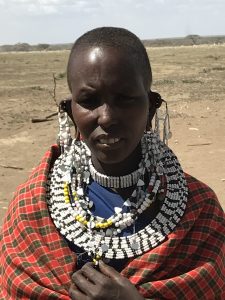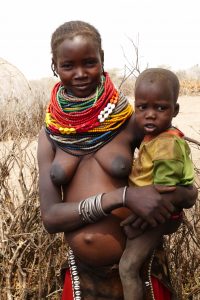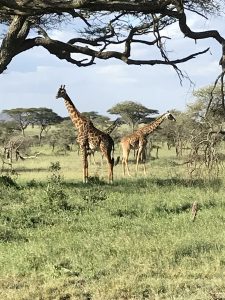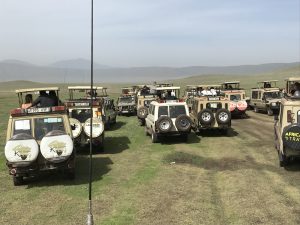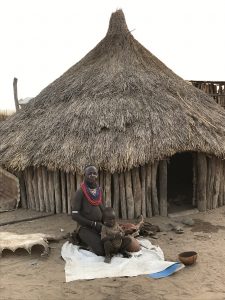Globalization versus Cultural Survival
or: Do Humans Belong in a Zoo?
This may seem like a provocative question – which it is – but the answer may not be as obvious as it might seem.
This blog will look at two very different cultural challenges from Africa. The well-known Maasai as well as Africa’s most colorful tribes living in the Omo River Region of Ethiopia.
- Maasai woman with jewelry.
- Maasai youth during their induction to manhood.
- Young mother in The Lower Omo region.
There are voices that say we should value and preserve cultures or practices simply because they are unique or because they have been in existence for a long time. Frequently these groups prefer to maintain their lifestyle and culture but face challenges when surrounded by modernity. To accomplish such an outcome may require isolation from an all-embracing modern world. The effect may be to place people and cultures in a zoo.

A biblical epic as millions of animals eat their way across the Serengeti on their annual migration.
Our three-generation family spent Christmas 2017 in a modern-day zoo for both animals and people. We visited the Serengeti, a vast plain that straddles the borders of Tanzania and Kenya. The Serengeti represents a unique accomplishment in that it preserves an entire ecosystem in which millions of animals survive much as they have for millennia. They live and breed and eat each other in a magnificent closed system. They share this space, climate and pattern with a number of nomadic herding tribes – the one we know best are the Maasai. We may not appreciate that the Maasai did not live off the wild game in their midst but raised cattle for meat, blood and milk and rarely killed and ate the game around them.
After surviving the arrival of the colonizers in the late 19th century, including the massive impact of communicable diseases – the Maasai and others continued to exist but their extensive land requirements did not fit well with the ideas and values of the colonizers. The best land was taken for plantations and other uses. The Maasai were forced to adjust and integrate. Those in the more remote areas survived together with the wild animals. At some point in time the outside world placed a value on the preservation of the space and the animals. It became necessary (or politically correct) to acknowledge that human beings such as the Maasai also relied on the same space. Strategies were slowly developed to include some degree of preservation of the Maasai and their way of life.
The Maasai are an amazing people. Many are going to University and other careers but will return to their village on weekends and emerge from their hut in totally traditional attire. However, with access to medicine and schools their population has soared. Their way of life and land restrictions make cultural continuity difficult if not impossible. Those villages near major roads or game parks frequented by tourists have been given the opportunity of opening their villages to visitors – but the price is to totally retain the character of your village, hut, your dress and your physical appearance.
Many of the Maasai are effectively living in a modern zoo with weekend and student passes. Your village guide is probably a University student home for the weekend and that is the reason for his perfect English. There are a million members of the Maasai and we met tribe members who are effectively assimilated into the modern world as well those in the living zoo. They are seeking accommodation and we admired their tenacity.
Leona and I together with a female hitchhiker were camping in the Maasai Mara in 1971. We were off-road and had a challenging encounter with young Maasai herders and their goats. Our filming was not appreciated and we were surrounded with spears and machetes drawn. We managed to escape unharmed and I was a bit disappointed that the spears thrown at the departing vehicle did not stick as a souvenir.
We returned to the same remote location a decade later with our daughters. At the last gas station we picked up a Maasai student returning to his village on condition he would translate for us. We encountered a Maasai couple and purchased their weapons and decorations. They advised that without weapons they could not get home safely. We drove cross-country to their village and were well received by the chief and the tribe.
- Elephants thrive if protected from poachers.
- The King or Queen of the Serengeti. Hunting is hard work.
- Giraffes in an elegant pose.
While there are great efforts to accommodate the traditional lifestyle of the Maasai (where they share space with the animals) it could be argued that the value is not the Maasai but rather the values of the outside world to preserve the natural habitat for the animals. It makes us feel good when we do something like the preservation of the wonderful game reserves and some level of survival of species that are photogenic. It has the added benefit of creating fabulous vacation destinations for the rest of us.
- Game reserves and tourism drive the economy.
- The vultures and the land cruisers gather when there is a spectacular kill.
What happens when the natural endowment is different? What is the balance between the preservation of nature and the preservation of a people?
Ethiopia is the genuine “cradle of civilization” in terms of the earliest traces of human existence. The museum in Addis Ababa dedicated to “Lucy” is an essential visit. Ethiopia has a highly developed culture and religion at the center. The Coptic tradition is one of the oldest among Christian churches. The dynasty represented by the former Emperor Haile Selassi traces its origins to King Solomon and Queen Sheba of Axum. However, the geography (and possibly the absence of colonization) of Ethiopia has allowed remote but often well-developed and stable traditional cultures to survive better than in most of the rest of Africa. Our family Christmas this year included a visit to the Lower Omo River region.
In 1993, together with my University-age daughter we travelled by Land Rover from Eritrea and the Red Sea the full length of Ethiopia. Our objective was to visit as many of the culturally isolated and traditional tribes as we could. Our final destination was the extreme southwest of Ethiopia where the Omo River flows into Lake Turkana. The Communist period and the civil war had just ended. It was still somewhat precarious but the war had prevented or discouraged Government, missionaries, anthropologists and tourists from engaging with these tribes. It was a rare opportunity to encounter them close to their original cultural state.
The Omo river emerges from Central Ethiopia and winds south toward Lake Turkana. The South Omo and Turkana regions are among the most remote and desolate regions of Africa. They also host a group of tribes who have competed for scarce resources and are secure in their identity and culture. They have developed traditions around jewelry, dress, body paint and dance that are incredibly decorative and colorful. Much of the decoration including paint and body scars are related to warfare, mating and hunting and battle prowess.
- Jewelry, goatskin, cowry shells and body paint. Three young beauties.
- They wear this jewelry most of the time.
- Body scars reflect bravery and beauty.
In 1993 we had access to a vintage Land Rover pickup together with the Swede who had floated the vehicle to this roadless desert. The fleet included two trail bikes on the back of the pickup. We visited the Nyangatom, a more primitive version of the Maasai. We joined the Hamar on their market day and collected some great jewelry. The most interesting experience was a chance encounter with 5 members of the Mursi as we trekked on foot through the badlands. The three men and two women were not dressed for any occasion – in fact they had no body paint and no clothes. They did carry their spears! The Mursi are known through National Geographic images wearing the round plates in their lips and ears. They only number 5,000 and are the most remote of any group in the region.
The Mursi pointed to our motorcycles on the pickup and expressed great curiosity. Once they saw them doing circles on the badlands hills they became excited and insisted on a ride – all of them jumped on the back – including the naked women and squealed with delight. It became a very human encounter – then they silently disappeared into the desert.
The only reliable evidence of civilization was the presence of guns, especially AK47’s flowing across the border from the civil wars in Sudan. We were told that the shift from spears to guns in local fighting about cattle and women had been disastrous – resulting in a severe shortage of adult males.
Our Yellow Land Rover had passed a Nyangatom village on the way to meet us and had clipped a goat. When we returned the enraged chief rushed out to meet us with his AK47. He had plenty of body scars to indicate that he was familiar with the use of the weapon. Our local friends calmed him down, we negotiated the purchase of the goat for our dinner and the goat, chief and gun joined us on the back of the pickup for the trip to the Omo River. Later as we shared a campfire he presented a ring to my daughter – she was unsure whether she was now engaged!
The world is coming to the Lower Omo whether anybody there wants it or not!
On this return visit this Christmas we encountered four tribes. We made a return visit to the Hamar and Nyangatom and new visits to the Daasanach who straddle the border with Kenya and the tiny 1500 member Karo tribe. Ethiopia has arrived on the tourist trail and is a spectacular destination. The Lower Omo and its colorful tribes have joined the rush. The destination is still limited with only 200 available beds. We made a late decision and found refuge in a seldom-used hunting lodge next to a Karo village.
- Daasenach village. The construction reflects the degree to which they are nomadic.
- Nyangatom men in full body paint and with their gun.
- Daasenach mother and child.
With regular visits from tourists the tribal people have learned that access to the village and the opportunity to take photographs have substantial value to the tourist. The process is still new and therefore requires some degree of negotiation with each visit to a village. Once the transaction is complete the villagers are excellent hosts. Nevertheless, the transaction and the nature of the visit offends our perceived cultural sensitivities. In a few years the transaction will be standardized. The huts will remain free of tin sheets, the men will paint their bodies even if there is no harvest festival or imminent battle, the women will be loaded with jewelry and keep their breasts uncovered and the children will remain close to nature.
Is this a good description of a Zoo?
Tourism is the lesser problem. Ethiopia has a very centralized and authoritarian Government and not unlike other countries in Africa believes that modernity is inevitable and in fact desirable. Gibe III is a massive dam recently built on the Omo River. Gibe IV and Gibe V are on the way. These dams will divert water to hundreds of thousands of acres of plantations and as byproduct end the seasonal flooding used by tribal people to grow crops such as sorghum to supplement their cattle. The land is being leased to corporations from Malaysia, Italy, India and Korea to grow commercial crops. The largest and potentially most devastating project is the giant 245,000 hectare state-owned Kuraz Sugar Project. These projects will eliminate most of the land used to herd cattle plus destroy the seasonal crops along the river. The tribes are being herded into resettlement camps with a remnant of their herds and promised services from the Government. Expectations of the reality of these services are very limited.
The Chinese as usual are the builders. Paved roads and modern bridges cut through traditional villages. The foreign workers bring many undesirable social habits and leave behind many mixed-race children that they nor the locals want.
There are 200,000 members of 8 different tribes in the Lower Omo. All of them represent variations of a cattle and herding lifestyle. They are incredibly tenacious and have survived in the harshest of climates – but they cannot survive the predations of globalization. They are also colorful, photogenic and culturally unique – but this uniqueness is closely related to their isolation and lifestyle.
They are a tourist curiosity at the moment but this will disappear when they are no longer isolated and leave their cultural distinctions behind. Even if tourists are interested in a certain number of carefully managed villages – and if the tribals choose to live that way – this represents an opportunity for a tiny fraction of this population.
If a few villages try to retain their traditional look and feel but are surrounded by a sea of destructive economic development and social disfunction – which tourist will show up? The Maasai near the Serengeti have the advantage of living in what is essentially a giant park located on the pathways to some of the world’s great tourist attractions – the Serengeti, the Ngorongoro Crater and the adjacent Mt. Kilimanjaro. Who will come to see sugar plantations and rural slums?
The point could be made that the real value to global society of the Serengeti is the animal world – and the protection of the Maasai is a byproduct. In the absence of another tourist appeal such as world class game reserves I fear the Lower Omo will become a human wasteland.
Identity expressed as culture, lifestyle, beliefs and territory represents the fuel for many of the conflicts around the world. The dominant nations express identity in terms of power, arrogance and dominance. The smaller and more remote groups fight to retain some semblance of what they consider critical to their identity. This search for identity frequently leads to conflict.
Examples are the smaller nations of Europe and many of the indigenous groups in the Americas and elsewhere. The cultural survival of groups in the Middle East such as the Kurds, Yezidis, Egyptian and other Christians, Israel and other minorities keeps conflicts alive or at a minimum results in international and communal friction.
My recent Blog #41 about the Rohingyas is an example of competing cultural and ethnic narratives that can result in a human catastrophe.
The narratives of the Maasai and the Lower Omo tribes suggest that cultural survival in their traditional form will be difficult. Both are minorities within a larger political state within a rapidly globalizing world. They will need to come to terms with the modern world and a few may survive for some time in a form of human zoo.
Directly west of the Lower Omo is South Sudan, the world’s newest country. I was sitting at dinner in Juba with a table full of international types back in 1983. We fell silent as we listened to the AFRICA BROADCAST of the BBC. We heard the words – “Sudan has introduced Sharia Law”. After a moment of silence someone remarked – “you did not hear a shot but a war just started”. Several decades of war ensued with the ‘Christian’ Dinka and Nuer fighting the Islamic Central Government.
The eventual outcome was the independent country of South Sudan. Now the two tribes that together represent the majority fight each other in another devastating war. Both are strong enough to strive for power but neither is strong enough to win.
Concluding Thoughts
Cultural survival is less about politics and more about power. If we consider the comparative cultures of countries such as America, France, Israel, Saudi Arabia or Japan they have very different cultural, religious and lifestyle expressions within the context of a modern world. The cultures represented by minorities or small groups such as the Yezidis (Blog #19) or the Omo River tribes cannot dictate land use, political forms of Government or international relationships. They live at the pleasure or mercy of others – and mostly the others do not care.
Japan and Saudi Arabia can create the policies to sustain their preferred way of life. The Omo River tribes, the Maasai and a few others will need to integrate into the culture of others and a few may survive in what will essentially be a human zoo.

